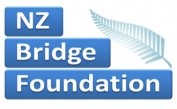
GRAND SLAM BIDDING
North Dealer Nil vulnerability
![]() AKxx
AKxx
![]() A
A
![]() AKxxx
AKxxx
![]() Axx
Axx
![]() xxxxxxx
xxxxxxx
![]() xxxxxx
xxxxxx
![]() -
-
![]() -
-
How do you bid 7![]() ?
?
Latest Posts on this Thread
- SEAN LYNCH02 May 2019 at 09:00PMThis is an interesting hand that would be a challenge for many systems. Our Imperspicuity bidding would be:N. S1
 <= 6 L 0 - 37 HCP 1
<= 6 L 0 - 37 HCP 1 <= 8 L 5+
<= 8 L 5+ 1N. SAR. 4
1N. SAR. 4 <= 6 L 7
<= 6 L 7 6
6 6 total losers4N LAR. 5
6 total losers4N LAR. 5 6 L7
6 L7 As responder at best can only have Q
As responder at best can only have Q or Q
or Q from law of total losers, bid 7
from law of total losers, bid 7 as can ruff out hearts.Interestingly if the North and South hands were swapped our bidding would be:N. S1
as can ruff out hearts.Interestingly if the North and South hands were swapped our bidding would be:N. S1 <=6 L 0 - 37 HCP 1
<=6 L 0 - 37 HCP 1 >8 L or <= 8 L 4M 1
>8 L or <= 8 L 4M 1 6 L 5+M. 1N 9 L or <= 8L 4M3N 6 L 6+
6 L 5+M. 1N 9 L or <= 8L 4M3N 6 L 6+ 6+
6+ 4
4 CROSS4
CROSS4 0-3 key card
0-3 key card  4
4 CROSS5
CROSS5 0-3 K 5
0-3 K 5 CROSS5
CROSS5 0-3 Q 7
0-3 Q 7 With a 1.5 loser hand responder is looking for a grand slam after the opening bid using the rule of 18 if a suitable fit exists. From the law of total losers opener has a 76 shape as the opener has no cards higher than J so South bids 7
With a 1.5 loser hand responder is looking for a grand slam after the opening bid using the rule of 18 if a suitable fit exists. From the law of total losers opener has a 76 shape as the opener has no cards higher than J so South bids 7 on basis hearts split 3-2 and spades 2-1 if North has 7
on basis hearts split 3-2 and spades 2-1 if North has 7 or can ruff out
or can ruff out  suit if instead has 7
suit if instead has 7 as before.Our methods allow both hands to be opened constructively with 1
as before.Our methods allow both hands to be opened constructively with 1 as they are both are <= 6 L hands and both should be able to make a 1 level contract with little assistance from partner.
as they are both are <= 6 L hands and both should be able to make a 1 level contract with little assistance from partner. - Brad Johnston03 May 2019 at 11:57AM
1D 1S;
4N 5D;
5H 7S
North could splinter in hearts over the splinter, but they're never not asking for the QS, so may as well just do that.
South shows their 0 keycards.
North asks about the Q, and South has 3 more spades than they've shown. That sounds like the Queen won't be an issue in an 11 card fit; and surely two side-voids is so grand posisitive too that South can't not bid 7S. - Brad Johnston06 May 2019 at 10:52AM
Also Sean, I'm not sure that your Imperspicuity auction would be legal if you rotate the hands.
If you look in the NZB manual, Page D8 deals with the strength definitions.
"Opening strength" is 11+ HCP; or equivalent with allowance for distribution (1 point per every card above the 8th in your two longest suits).
"Strong" is 15+ HCP or equivalent. A 7-6 yarborough has "equivalent strength" to 5 HCP according to the NZ Bridge definition; so this hand couldn't be opened at the one level (to show an opening hand) without it registering as a psyche; and it definitely doesn't match the definition of a "strong" precision opener.
It's all well and good to devise pet systems like this; but I impore you not to attempt to play them in sanctioned NZ Bridge events until you work with a qualified national director to come up with a sufficient level of suggested defences; as you're effectively opening a wide-ranging fert here under the guise of a strong hand. - SEAN LYNCH10 May 2019 at 01:02AM
Hey Brad,
Thanks for your feedback.
The definition for “opening strength” that you have referenced in the NZ bridge manual only technically applies to the National Rubber Bridge Competition which only allows limited systems. It doesn’t apply to NZ bridge sanctioned Open “A” point tournament events.
Imperspicuity is a Red system that can be played in Open A point pairs, Swiss pairs, and team tournaments.
For an opening bid with 0-7 HCP to be a yellow system the key definition from the NZ bridge manual page D45 is:
An opening bid at the 1 level that may be made with values a King or more below average strength (0?7 HCP) and insufficient compensating distributional values.
Logically as a 0 HCP opening hand is not specifically excluded from being opened in a Red system by the above definition a hand distribution must exist that has sufficient compensating distributional values to do so. A hand with a 9 card suit to the T with a 4 card side suit and 0 HCP would be the most extreme distribution possible. This would meet the definition of a 6 loser hand. It therefore follows that any 6 loser hand with 0 HCP would then meet the same definition and can be opened at the 1 level using a Red system. Similarly it can be argued a 9-3-1 shape 0 HCP 7 loser hand is sufficiently similar to a 9-4 opening to have sufficient compensating distributional values and would be expected to make a 1 level contract with a little assistance from partner. Similarly, it follows this would also allow all 7 loser 0 HCP hands to be opened at the 1 level using a Red system.
We don’t play many tournaments these days as my playing partner is too busy but an earlier version of our system card using these opening definitions has been previously examined by a national director and allowed to be used in an A point pairs event, A point Swiss pairs event, and an A point teams event as a Red system.
The announcement for the Imperspicuity 1
 opening is “unusual” not “strong” and the HCP range is pre-alerted. The HCP range is not disguised.
opening is “unusual” not “strong” and the HCP range is pre-alerted. The HCP range is not disguised.Instead of using HCP for opening hand evaluation Imperspicuity evaluates playing ‘strength’ of hands based on losers which is how the wide HCP range arises for the 1
 opening (0 - 37 HCP). The bid differ from fertiliser bids (fert) in that it shows potentially strong playing strength hands with precisely 6 or less losers capable of at least making a 1 level contract without assistance from partner assuming normal distribution.
opening (0 - 37 HCP). The bid differ from fertiliser bids (fert) in that it shows potentially strong playing strength hands with precisely 6 or less losers capable of at least making a 1 level contract without assistance from partner assuming normal distribution.Any defences developed for an unnatural 1
 opening can be used but defences will work better that have more precise loser or HCP ranges for overcalls and doubles, or at least a means to later check back overcaller’s strength.
opening can be used but defences will work better that have more precise loser or HCP ranges for overcalls and doubles, or at least a means to later check back overcaller’s strength. - Brad Johnston10 May 2019 at 11:33AM
I disagree Sean - I think you're creating your own logical loophole and trying to jump through it as many times as possible.
I think it's impossible to create a strongly cohesive set of regulations surrounding the high card point strengths allowed for certain actions (see the relatively recent debate about people opening a 2C opening bid because the hand didn't have very many losers) that got rolled back because it was deemed "illegal" to open 2C on that hand.The English bridge union have their own teething problems with stating specific ranges for bids like strong 2's using "the rule of 25", and there are always hands that people feel are exceptions. I commend the effort that NZ Bridge have made in codifying the rules around the strength of bids; as for the most part they read very cleanly and sensibly. The issue is that everyone needs to conform to them.
If you think about it, any time people put a hard cap on a hand; someone comes up with an example hand that doesn't meet the definition and attempts to bludgeon it through. The reason that 0-7 HCP hands are allowed to be opened with sufficient compensating distribution is that the HCP range that everyone in NZ agrees to open is "no more than a king below average" or 7+ HCP.
However there have been known to be hands such as:
AQTxxxx
Xxxxxx
-
-
This hand demonstrably has the playing strength to be opened at the one level; so is allowed through the 'compensating distribution clause'. The issue with your argument is that you've conveniently neglected that NZ Bridge provide their own definition as to what compensating distribution means - recall the '1 HCP per card above 8 in your two longest suits'.
As per this definition, you only ever get to 5 adjusted HCP, and no matter way you slice it you find that this doesn't meet the Red regulations. I have nothing against people playing methods such as Crunch; which relay on these destructive and non-informative one-level opening bids - but a pairs tournament is not the place to play this.
I understand that you focus solely on losing trick count; but the manual isn't written that way. I can't value my hands such as I upgrade a "Bradley point" for each 7, and two "Bradley points" for each 8 I own. This is a valid way to evaluate hands; in that I can receive a hand and make a judgement as to how good it is; but it'll only be slightly less relevant than a completely loser based system in my opinion as to assessing the strength of the hand.
To use two example hands:
7600 yarb in title post:
HCP = 0 (~11 avg to open)
NZ Manual adjusted HCP = 5 (Still not enough to open)
'losers' = 6 (~7 avg to open)
Kaplan and Ruebens = 5.7 (~11 avg to open)
Zar points = 20 (~26 to open)
76 6 count above:
HCP = 6 (~11 avg to open)
NZ Manual adjusted HCP = 11
'losers' = 4 [You wouldn't see me opening 2C on this hand...]
Kaplan and Ruebens = 13.8
Zar points = 28
This shows that there are hands with fewer than 7 HCP that every sound system would judge to open, however I think you'll find that trying to argue that a 94 yarb meets this definition isn't bridge as specified in the NZ Bridge Manual. - Brad Johnston10 May 2019 at 11:35AM
I disagree Sean - I think you're creating your own logical loophole and trying to jump through it as many times as possible.
I think it's impossible to create a strongly cohesive set of regulations surrounding the high card point strengths allowed for certain actions (see the relatively recent debate about people opening a 2C opening bid because the hand didn't have very many losers) that got rolled back because it was deemed "illegal" to open 2C on that hand.The English bridge union have their own teething problems with stating specific ranges for bids like strong 2's using "the rule of 25", and there are always hands that people feel are exceptions. I commend the effort that NZ Bridge have made in codifying the rules around the strength of bids; as for the most part they read very cleanly and sensibly. The issue is that everyone needs to conform to them.
If you think about it, any time people put a hard cap on a hand; someone comes up with an example hand that doesn't meet the definition and attempts to bludgeon it through. The reason that 0-7 HCP hands are allowed to be opened with sufficient compensating distribution is that the HCP range that everyone in NZ agrees to open is "no more than a king below average" or 7+ HCP.
However there have been known to be hands such as:
AQTxxxx
Xxxxxx
-
-
This hand demonstrably has the playing strength to be opened at the one level; so is allowed through the 'compensating distribution clause'. The issue with your argument is that you've conveniently neglected that NZ Bridge provide their own definition as to what compensating distribution means - recall the '1 HCP per card above 8 in your two longest suits'.
As per this definition, you only ever get to 5 adjusted HCP, and no matter way you slice it you find that this doesn't meet the Red regulations. I have nothing against people playing methods such as Crunch; which relay on these destructive and non-informative one-level opening bids - but a pairs tournament is not the place to play this.
I understand that you focus solely on losing trick count; but the manual isn't written that way. I can't value my hands such as I upgrade a "Bradley point" for each 7, and two "Bradley points" for each 8 I own. This is a valid way to evaluate hands; in that I can receive a hand and make a judgement as to how good it is; but it'll only be slightly less relevant than a completely loser based system in my opinion as to assessing the strength of the hand.
To use two example hands:
7600 yarb in title post:
HCP = 0 (~11 avg to open)
NZ Manual adjusted HCP = 5 (Still not enough to open)
'losers' = 6 (~7 avg to open)
Kaplan and Ruebens = 5.7 (~11 avg to open)
Zar points = 20 (~26 to open)
76 6 count above:
HCP = 6 (~11 avg to open)
NZ Manual adjusted HCP = 11
'losers' = 4 [You wouldn't see me opening 2C on this hand...]
Kaplan and Ruebens = 13.8
Zar points = 28
This shows that there are hands with fewer than 7 HCP that every sound system would judge to open, however I think you'll find that trying to argue that a 94 yarb meets this definition isn't bridge as specified in the NZ Bridge Manual.
Click here to log in.




